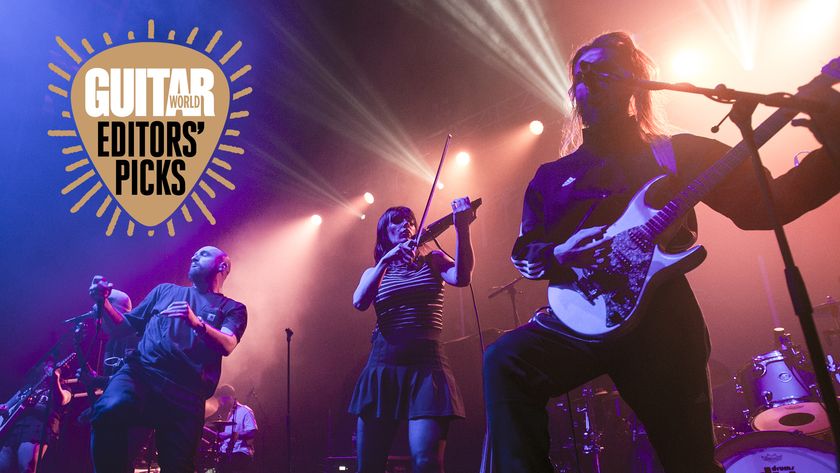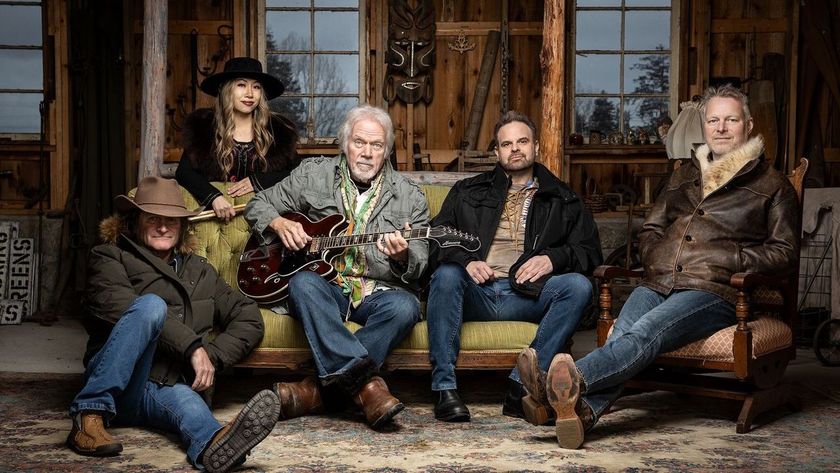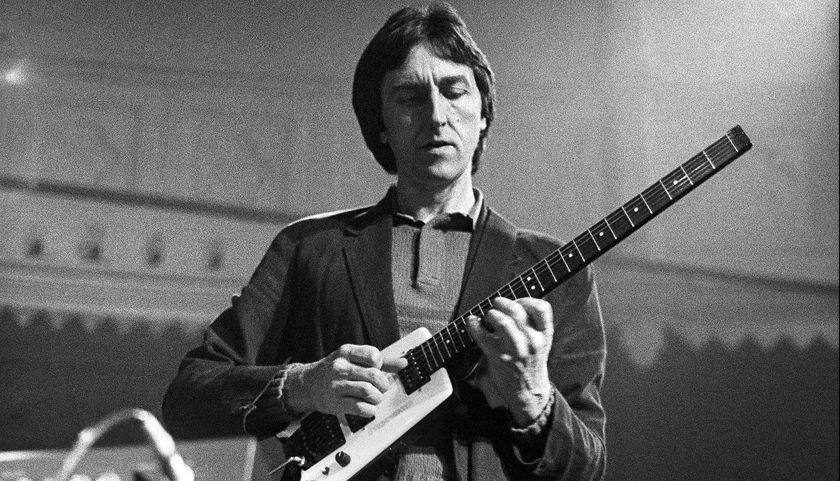Girl on Fire: Orianthi Turns Up the Heat on Her New Album, 'Heaven In This Hell'
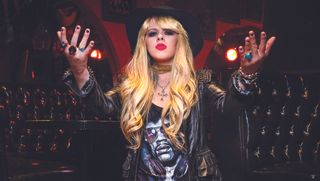
It’s hard to keep up with Orianthi these days. The guitarist, who hails from the South Australia city of Adelaide, has been touring the world as a member of Alice Cooper’s band for the past year and a half.
When Guitar World finally catches up with her in Los Angeles, she’s just returning to the mainland from a show in Hawaii. Beyond the pleasures of globe trotting, she is clearly enjoying her long-running stint with the celebrated shock-rocker. “We get to celebrate Halloween all year long,” she says. “And I have the best seat in the house every night.”
It’s a pretty good arrangement for Cooper as well, as Orianthi is one of popular music’s most in-demand players. She is the rare modern guitarist who is equally adept at playing rock, pop, country and blues, not to mention capable of standing toe-to-toe with some of today’s best shredders.
Though only 27 years old, she has played alongside everyone from Cooper, Carlos Santana (her first idol) and Steve Vai to Carrie Underwood, Prince and Michael Jackson, whose band she was a member of for his ill-fated This Is It comeback shows in 2009.
In addition to her always-busy schedule with other musicians, Orianthi records and performs her own music. Her self-released solo debut, Violet Journey, came out in 2007, though it was the 2009 follow-up, Believe, which featured the slick pop-rock hit “According to You,” that proved to be her breakthrough.
Now’s she’s back with Heaven in This Hell, perhaps the most accurate representation to date of her varied style as an artist and a player. The record incorporates everything from heavy modern rock (“You Don’t Wanna Know”) to country-inflected balladry (“Another You” and “Rock”) to widescreen, soaring pop (“If You Think You Know Me”). But mostly there is gritty, bluesy hard rock laced with plenty of incendiary six-string work, as evidenced on the slide-guitar-powered “Fire,” the SRV-influenced “Frozen” and the swampy, wah-drenched title track.
“I’d been listening to a lot of Robert Johnson and Howlin’ Wolf,” Orianthi says about the inspiration behind the album, which she recorded in Nashville with former Eurythmics guitarist Dave Stewart at the helm. “I think you can hear the Delta blues thing in something like the intro to ‘Heaven in This Hell,’ which has that down-home acoustic riff.” Still, these aren’t songs meant for front-porch picking. Rather, Orianthi says, “With every track it was like, How is this gonna go down live? That was the main thing I had in mind when writing and recording these songs. We wanted it to be a blast to play onstage.”
The stage is clearly where Orianthi shines, and she has plans to take this material out on the road as a solo act—if she ever finds the time. She has dates booked with Cooper for much of 2013, and there’s no telling who might come knocking on her door after that. When asked which artists she would most welcome an opportunity to play alongside, Orianthi doesn’t hesitate with her answer: “B.B. King or Eric Clapton. I played at the Crossroads Guitar Festival in 2007, but I’d love to actually do something with Eric. And B.B…he hits one note, and that’s all you need. He’s amazing.”
Given Orianthi’s track record, smart money would bet that these collaborations might happen sooner than she thinks. “I don’t know about that,” she says with a laugh. “But it’d be very cool…”
GUITAR WORLD: Heaven in This Hell has much more of a blues-rock vibe than your past work. Is that where your influences lie?
I was inspired to play electric guitar from listening to a lot of Carlos Santana, Stevie Ray Vaughan and B.B. King, and that’s always been the kind of music that I gravitate toward. My last record, Believe, was certainly a more commercial record. There was some rock and also a bit of blues, but overall it was more pop. But this time I went back to what I first loved and didn’t overthink it.
Also, Dave [Stewart] is a huge blues fan. We jam a lot of blues on his porch all the time. We started working together because he was making a record at Blackbird Studios in Nashville, and he said, “Come down, check it out.” So I ended up hanging out there for two days and just watching his incredible band, these amazing studio musicians. And I thought, I want to do a record like this. I wanted everyone in a room together, just playing the songs. And we had so much fun. It was really inspiring.
A lot has been made of your relationship with Carlos Santana. How does it feel to have someone who was a childhood idol become a peer and a friend?
It’s pretty crazy. I was actually just out in Seattle with Carlos. He was being honored at the EMP [Experience Music Project] Museum, and I was invited to play. I was doing things like “Jungle Strut” and “Everybody’s Everything” [both from 1971’s Santana] And he was sitting on the couch watching me. I don’t get nervous very often, but I was like, “You’re listening to me play all of your solos. I’m pretty nervous right now.” [laughs] It was surreal. But truthfully, every time I’m around him, I’ll always be in awe. He’s the reason I play electric guitar. His playing is like church. It’s so powerful.
Is it true that you wrote and recorded a song for him when you were 14 years old?
Yes. I did a demo with my dad called Under the Influence. We had this band come over to the house and set up in the kitchen and the living room, and we recorded five songs for a CD. One of them was called “Song for Carlos.” And I sent that CD everywhere, including to Santana’s management.
His brother, Jorge, who works with them, sent me an email that said, “We’ve been playing your CD in our office. We really love it.” That was pretty crazy. Then when I was 18, Carlos came to play in Adelaide and I sent a press kit and CD to his hotel. I just wanted to meet him. I think he probably thought, My gosh, this girl’s insane! But I got to meet him and he said, “Hey, do you want to jam onstage tonight?” And this was in front of, like, 15,000 people. He didn’t even tell me what song we were going to play. We just jammed out for 40 minutes. It was one of those moments I’ll never forget.
It seems you’ve had more than your fair share of unforgettable moments, especially for someone so young. You opened for Steve Vai when you were just 15.
Steve was really the first musician who gave me support. I played with him at a nightclub in Adelaide called Heaven. It was just me. There was no band—I was playing to a track. And all these guys in the audience were just standing there with their arms folded. But Steve was actually watching me from offstage, which felt good. And when he went on that night, he came out with the miner’s light on his head and lasers on his fingers, and I was just like, “Oh, my God.”
It was like Jeff Beck meets Jimi Hendrix. Unfortunately, I couldn’t stay for the whole show, because I was underage. [laughs] But after that, we stayed in contact. I would send him demos, and he would actually listen to them and write back and say things like, “I think this part’s really good,” or, “Maybe if you change this part…” Having his guidance has been super-inspiring. He’s been like an uncle to me.
The two of you recorded a guitar instrumental called “Highly Strung” for your last record. There’s some great playing on it.
That was a lot of fun. The guitar parts you hear on that were actually recorded at his house. We did a demo there and it just had the energy, so we kept it. So those are all demo guitars. Really, the whole thing was improvised. It was like, “I have this idea. Let’s play the riff together. And then you do something and I’ll do something. Then we’ll play the riff again.” Just figuring it out. It was a real honor to do that. He’s such an innovator.
Another innovator that you’ve had the opportunity to work with is Michael Jackson. You were the last guitarist to play with him before his death. How did you come to be in his band?
I was recording with Dianne Warren when I got an email from his people. They had watched some of my YouTube videos and wanted me to come in and audition. And I thought, Is this a joke? But my manager reached out to them, and he said, “It’s for real.” Truthfully, I didn’t even think I was going to get it.
Because, I mean, I’ve listened to Van Halen and all that, but I’m not really that style of player; I’m more of a blues person. But I went in there and I played “Wanna Be Startin’ Somethin’,” “Dirty Diana”… I played the “Beat It” solo but I did my own take on it. Because I’m not going to fill Eddie Van Halen’s shoes. I’m not going to fill Jennifer Batten’s shoes. They’re amazing at what they do, but I just said, “I’m going to do my own thing.” And I did.
What do you recall of Michael from the audition?
I remember that he wanted to hear it really loud. [laughs] He had them turn everything up. But basically, he just sat on a black couch and watched me play. That was probably the most nervous I’ve been in my life. But really, working with Michael was amazing. I remember the first time he danced. I remember him singing “Billie Jean” in front of me. And it’s funny, because then I would go home to my apartment and I’d be cleaning up dog crap, doing normal things. And I’d be thinking, What just happened? And I couldn’t tell anybody for quite a while. It was a secretive thing. Like, “Hey, what are you doing today?” “Ah, nothing…”
While we’re on the subject of enigmatic characters, you’ve also jammed with Prince. What was that experience like?
I was at home and he called me. Like, “Hey, Orianthi. This is Prince.” And what was weird was I had just watched his performance at the Super Bowl, where he did that Foo Fighters song, “Best of You.” And it was amazing. So I’m thinking, Are you serious? And again, he tells me that he had seen some of my YouTube videos and he wants to jam. He said, “I’m going to be at the Record Plant tomorrow and I’m flying down Shelia E. We’ll jam at one o’clock.” And I was like, “Okay!”
So I showed up with my guitar, and he said, “You play one of your ideas, and I’ll play one of mine.” He played bass, I played guitar, and Shelia played drums. We jammed for, like, two hours. And I remember he put his ear right up to my amp, because he wanted to hear everything I was playing. [laughs] That was pretty crazy.
We wound up hanging out for three or four days. We went to a jazz club one night. Another night he played an unannounced show in a hotel lobby. And it was just full of all these people; I think Terrence Howard was in the front, Penelope Cruz... Crazy. He said to me, “Where’s your guitar?” But I didn’t bring it. I didn’t want to be presumptuous. I thought it’d be weird, like, Yeah, it’s right here on my back.
When you play with musicians in various genres, do you tailor your gear to fit the project?
It depends. I always use PRS guitars, but I might change up which ones. With Alice [Cooper], I’m using Custom 24s with Floyd Rose tremolos and thin necks. And I play heavier-gauge strings, because we detune. I also have a Whammy Pedal. Those are all things I need for Alice’s music. But if I’m doing a small, bluesy gig, I’ll take maybe a Custom 22 and a wah pedal. Then with Michael [Jackson], I had a lot of different guitars because I needed to get that funky tone. For amps, I’ll try different things, but lately I’ve been playing mostly the Fender EVH 5150 III.
What was your main gear setup for Heaven in This Hell?
I brought my PRS 22, and I used my own model [the PRS SE Orianthi] for leads. I actually also used an old Strat for some rhythm parts as well, just for a different texture. For amps, it was mostly an old Fender Twin. Then I had a Cry Baby wah, and also a Boss Octave pedal, which you can hear at the beginning of “Heaven in This Hell,” where it comes in super-heavy.
Do you prefer recording and performing your own music or being a part of someone else’s project?
I love both, and I hope I can continue to do both. Being the frontperson is great, because you’re running the show. And I love the guys who play in my band. But then it’s also so much fun to be part of someone else’s band. And I actually see myself more as a guitar player. So it’s really a cool thing to be able to do all of this. But it’s also a lot of work. Getting ready for a tour is a big process, and I enjoy every part of it. Because you learn so much. With Alice’s tour, we had to learn something like 25 songs in a week.
What would you say is the key to being a good side person?
Just play it like you mean it. You have to be present in the moment and be able to harness that energy and also project that energy out at the listener. With Alice, for instance, he takes his audience on a journey every night. And I want to be a part of that journey, not just somebody onstage watching it happen. So you have to go out there and give it everything you’ve got. No matter what you’re doing, make sure you’re not doing it half-assed.
Photo: Jeremy Danger
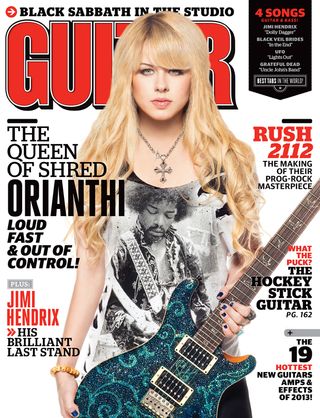






Get The Pick Newsletter
All the latest guitar news, interviews, lessons, reviews, deals and more, direct to your inbox!
Rich is the co-author of the best-selling Nöthin' But a Good Time: The Uncensored History of the '80s Hard Rock Explosion. He is also a recording and performing musician, and a former editor of Guitar World magazine and executive editor of Guitar Aficionado magazine. He has authored several additional books, among them Kurt Cobain: Montage of Heck, the companion to the documentary of the same name.
